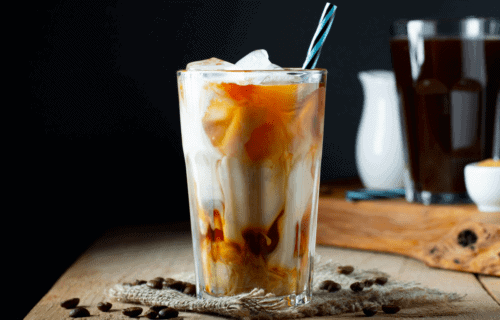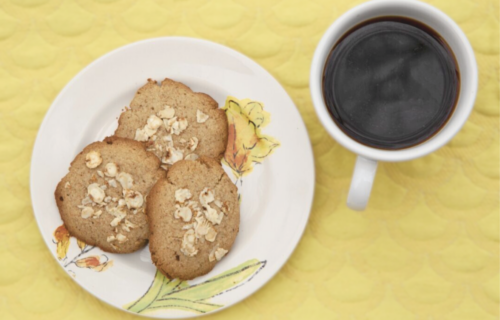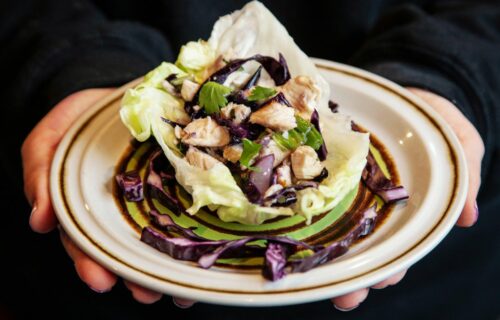
Lower Histamine Elderflower Sparkling Wine Cocktail (plus Mocktail option) Recipe – also low FODMAP, low lectin, low oxalate
With New Year’s Eve coming up, I wanted to treat myself to a special cocktail. And I wanted to make something our community might be able to have, too. So, I called my friend Justin who is a great mixologist.
We started experimenting and mixing. I wanted something bubbly and complex, but not too sweet.
We came up with something that we thought was outstanding. Even our taste tester, Shawna, loved it.
This bubbly Elderflower and Rosemary Sparkling Wine Cocktail is made possible by using a lower histamine sparkling wine. The bubbles make this drink feel festive and special. I’ll tell you more about where I got this sparkling wine next.
Lower Histamine Wine – what to know with Mast Cell Activation Syndrome or Histamine Intolerance
If you have Mast Cell Activation Syndrome or Histamine Intolerance, you don’t want to use just any wine.
I only drink lower histamine wines from Dry Farm wines.
Not only are Dry Farm Wines lower histamine, they’re also:
- Sourced from farmers who use organic and biodynamic farming methods
- Sugar Free
- Lower sulfites
- Lower alcohol
- Vegan
All of those points contribute to these wines being lower histamine with fewer mast cell-triggers.
If you want to learn more about what makes the wines from Dry Farm Wines better for those of us with Mast Cell Activation Syndrome or Histamine Intolerance, check out this article: Lower Histamine Wines – Can It Be True? What to Know When you Have Mast Cell Activation Syndrome or Histamine Intolerance
So where do you find these wines?
Go to Dry Farm Wines:
>>>>>Get Lower Histamine
Wine Here
Dry Farm Wines sources wines produced by small, biodynamic farms. Then they check every wine for sulfites, sugar, and alcohol levels.
This makes it so easy for us to find these healthier, much more mast-cell friendly wines.
They’ve got the sparkling wine you need for the Elderflower and Rosemary Sparkling Wine Cocktail, but you can also get reds, whites, and rosés!
There really are a lot of differences between Dry Farm Wines and other wines you’ll find on the market. I’ve done well with Dry Farm Wines. And some of my clients who have turned a corner with their health have been able to tolerate anywhere from ¼ of a glass to 2 glasses.
If you think you might be ready to try alcohol again, but you aren’t sure if you’ll tolerate it, consider starting very slowly. Maybe with just a few sips, even. If you do well, you can see how you do with a little more. Just increase your intake very gradually. Listen to your body and don’t push your limit.
This drink needs just a little pre-planning, and you will want to allow for shipping time, too. You might want to go ahead and order the Dry Farm Wines Sparkling Wine if you’ve got a party or special occasion coming up.
>>>>>Get Dry Farm Lower Histamine Wine Here
The Dry Farm Wines Sparkling Wine adds light, zesty flavor notes with mild floral and fruit undertones that complement the elderflower nicely in our Elderflower and Rosemary Sparkling Wine Cocktail.
Speaking of elderflower…let’s look at some tips on making the Elderflower Liqueur next…
Lower Histamine Elderflower Liqueur – Tips for those with Mast Cell Activation Syndrome or Histamine Intolerance
For this cocktail, we wanted those light notes of fragrant florals and citrus that are typically found in St. Germaine elderflower liqueur. But St. Germaine is full of sugar, and it’s high histamine.
So, I experimented with making my own lower histamine elderflower liqueur to replicate the St. Germaine flavor. I’ve got the recipe below.
But I want to point out some prep tips here first. And I want to share something great about elderflower with you, really quickly.
Elderflower has been shown in both in vitro and in vivo studies to have immune supporting benefits. And elderflower is high in antioxidants. It’s also been shown that it may help regulate inflammation.
How can you beat a lower histamine cocktail with no added sugar that also has immune supporting ingredients?
Ok, here are those important prep notes you need to know when preparing the elderflower liqueur. You’ll need the elderflower, naturally. You also need stevia, lemon rind and vodka. (Proportions listed below.)
Ideally, you’d use fresh elderflowers. But I don’t have a flowering elderberry bush available to me. You probably don’t either. That’s ok, though. This brand of dried elderflowers turned out to be really good:
And you’ll want to get these ingredients several days before you plan on making your cocktail.
You need to make the elderflower liqueur at least 48 hours in advance of when you plan to have the Elderflower Rosemary Sparkling Wine Cocktail.
This is to allow the elderflower to infuse and impart flavor into the vodka. Because of the alcohol, it won’t harbor any histamine-raising bacteria if you keep your utensils clean.
Be sure to give yourself enough time to plan for that! But the prep is really easy. It took me 5 minutes to throw it together.
Notes for Other Ingredients in the Lower Histamine Elderflower Cocktail — for those with Mast Cell Activation Syndrome or Histamine Intolerance
When it comes to the vodka you are going to infuse with elderflower, you want to use a top shelf vodka. It will be a lot cleaner. I used Prairie Organic Vodka.
Choosing organic vodka means you won’t be drinking toxic herbicides with your cocktail. And the top shelf vodkas will have fewer impurities and additives.
Be sure to use organic lemons here. Lemon rinds of non-organic lemons are usually waxed and contain pesticides.
While some citrus isn’t well-tolerated with Histamine Intolerance, lemon and lime are usually ok. I’ve always been able to tolerate a splash of lemon or lime, even at my sickest. But, you can leave it out if it doesn’t work for you.
For a non-alcoholic version you can use glycerin instead of vodka. If you do this, omit the stevia because glycerin is naturally sweet. If you go this route, be sure to use USP food-grade palm-derived glycerin (MUST be USP food-grade).
For the glycerin version: give it at least a week or more to infuse, as opposed to 48 hours for the alcohol version.
I put the mocktail option below, too. It’s tasty and fun, but it won’t be quite as complex in flavor.
How to Make the Smoked Rosemary Garnish
The garnish is a smoked sprig of rosemary held in a lemon rind curl. This trick came from my mixologist friend, Justin.
To smoke the sprig of rosemary, you just hold the rosemary over a match for a few seconds until it starts to brown. As long as you use fresh rosemary (don’t use dried rosemary!) it won’t catch on fire.
Smoking the rosemary brings out some of the lovely rosemary scent with the lemon. The reason we added this is that rosemary tasted too bitter when added to the drink. But the aroma of the smoked rosemary was a perfect way to balance the elderflower.
It’s a beautiful way to garnish the drink and creates what feels like a special and fun experience. You could skip this step if you prefer, though.

Final note: This is a strong drink! If you can’t handle much alcohol, you might want to share this with someone you love and just have a few sips.
Or check out the mocktail version at the end!
Lower Histamine Elderflower Sparkling Wine Cocktail Recipe

Elderflower Liqueur Recipe
This will make enough for 1 drink. If you are planning to make multiple cocktails, increase ingredients accordingly.
(This liqueur should last at least 1-3 weeks.)
Ingredients
¼ cup organic elderflowers
3 to 4 Tablespoons top shelf unflavored vodka (I used Prairie Organic unflavored vodka)
10 drops Better Organic Stevia
3” length of organic lemon rind – try to avoid the white pith
Tools
Small mesh strainer
Small glass jar with lid (don’t use plastic)
Chopstick or skewer
Directions
- Place elderflowers in glass jar.
- Add stevia to vodka and stir.
- Pour vodka mixture over the top of the elderflowers just until they are covered, but not much more.
- Use a chopstick or skewer to poke into the flowers and release any air bubbles.
- Cut the lemon rind into pieces and press onto the top of the elderflowers to protect them from air.
- Let it infuse for at least 48 hours in the fridge.
- After 48 hours, strain with a small, fine mesh strainer.
- Use a pestle or back of a spoon to press remaining vodka out of the flowers left in the strainer. This is an important step because this vodka will have the most flavor.
- If any solids are in the strained vodka, clean your strainer and pour the vodka through the strainer one more time.
- Store sealed in the fridge and out of light until ready to use.


Low Histamine Elderflower Sparkling Wine Cocktail
Makes 1 drink
Ingredients
3 tablespoons elderflower liqueur
2 teaspoons freshly squeezed organic lemon juice (optional)
½ cup Dry Farm Wines Sparkling Wine
1 piece of organic lemon rind for rimming glass
1 thick slice organic lemon for making garnish (optional)
1 sprig fresh, organic rosemary for garnish (use fresh, don’t use dried)
3 cubes of ice
Tools
Matches or a lighter
Cocktail shaker
Wine glass or champagne flute
Directions
- Start by lightly rubbing the lemon rind along the rim of your glass.
- Make your lemon curl garnish. There are a couple of ways to do this. You can either use a knife or a peeler. (see pictures above for reference)For the knife method: cut a slice of lemon. The thickness should be about the same as your pinky finger. Now cut into one edge of the rind. Your slice of lemon will then look like a circle with a notch in it.Now cut along the inside of the rind separating it from the flesh. You can cut all the way around or use your fingers to peel the fruit from the rind once you get it going.
You should now have just a slice of lemon rind. Roll the lemon rind tightly into a curly-q shape. One lemon should make anywhere from 4-5 garnishes.
For the peeler method: Start toward the top of the lemon. Peel all the way around the lemon one time. If you have a ribbon peeler, your section will be thicker and you can just use a knife to cut it in half.
Roll tightly into a curly-q. You’ll be able to do this several times to get anywhere from 4-5 garnishes per lemon.
- Add 3 cubes of ice to a cocktail shaker. Add elderflower liqueur and lemon juice. Shake vigorously for 15-20 seconds until cold.
- If your cocktail shaker doesn’t have a built-in strainer, remove ice cubes and pour chilled elderflower lemon mixture into glass.
- Top with sparkling wine.
- Using a match or a lighter, gently brown the rosemary for just a few seconds – only enough to bring out the rosemary scent.
- Slide the rosemary sprig into the lemon curly-q.
- Hang lemon rind and rosemary curly-q garnish on side of glass.
- Enjoy immediately. Or, if you’re preparing this drink ahead of time, keep it refrigerated and smoke the rosemary right before serving.
Enjoy your decadent low histamine cocktail and enjoy knowing you’re indulging in a way that’s much better for your body!
Low Histamine Elderflower Sparkling Mocktail Recipe
Makes 1 drink
Non-alcoholic Elderflower Syrup Recipe
Ingredients
¼ cup organic elderflowers
3 tablespoons USP food-grade palm-derived glycerin (MUST be USP food-grade)
1 tablespoon filtered water
3” length of organic lemon rind – try to avoid the white pith
Tools
Small mesh strainer
Small glass jar with lid (don’t use plastic)
Chopstick or skewer
Directions
- Place elderflowers in glass jar.
- Mix glycerin and water thoroughly.
- Pour glycerin mixture over the top of the elderflowers just until they are covered, but no more.
- Use a chopstick or skewer to poke into the flowers and release any air bubbles.
- Cut the lemon rind into pieces and press onto the top of the elderflowers to protect them from air.
- Let it infuse for at least 1 week. Can infuse for 2-3 weeks for stronger flavor.
- Strain with a small, fine mesh strainer.
- Use a pestle or back of a spoon to press remaining glycerin out of the flowers left in the strainer. This is an important step because this glycerin will have the most flavor.
- If any solids are in the strained glycerin, clean your strainer and pour the glycerin through the strainer one more time.
- Store sealed in the fridge and out of light until ready to use.
- You can easily double, triple, or quadruple this recipe if you want more – just scale up all the ingredients accordingly.
Low Histamine Elderflower Sparkling Mocktail
Ingredients
3 tablespoons elderflower syrup
2 teaspoons freshly squeezed organic lemon juice (optional)
½ cup sparkling water (with no additives – use unflavored Pellegrino or similar)
1 piece of organic lemon rind for rimming glass (optional)
1 thick slice organic lemon for making garnish
1 sprig fresh, organic rosemary for garnish (use fresh, don’t use dried)
3 cubes of ice
Tools
Matches or a lighter
Cocktail shaker
Wine glass or champagne flute
Directions
- Start by lightly rubbing the lemon rind along the rim of your glass.
- Make your lemon curl garnish. There are a couple of ways to do this. You can either use a knife or a peeler. (see pictures above for reference)For the knife method: cut a slice of lemon. The thickness should be about the same as your pinky finger.Now cut into one edge of the rind. Your slice of lemon will then look like a circle with a notch in it. Now cut along the inside of the rind separating it from the flesh.
You can cut all the way around or use your fingers to peel the fruit from the rind once you get it going.
You should now have just a slice of lemon rind. Roll the lemon rind tightly into a curly-q shape. One lemon should make anywhere from 4-5 garnishes.
For the peeler method: Start toward the top of the lemon. Peel all the way around the lemon one time. If you have a ribbon peeler, your section will be thicker and you can just use a knife to cut it in half.
Roll tightly into a curly-q. You’ll be able to do this several times to get anywhere from 4-5 garnishes per lemon.
- Add 3 cubes of ice to a cocktail shaker. Add elderflower syrup and lemon juice. Shake vigorously for 15-20 seconds until cold.
- If your cocktail shaker doesn’t have a built-in strainer, remove ice cubes and pour chilled elderflower lemon mixture into glass.
- Top with sparkling water.
- Using a match or a lighter, gently brown the rosemary for just a few seconds – only enough to bring out the rosemary scent.
- Slide the rosemary sprig into the lemon curly-q.
- Hang lemon rind and rosemary curly-q garnish on side of glass.
- Enjoy immediately. Or, if you’re preparing this drink ahead of time, keep it refrigerated and smoke the rosemary right before serving.
Enjoy your decadent low histamine mocktail, and enjoy knowing you’re indulging in a way that’s much better for your body!
Interested in more cocktail and mocktail options? Check out: Low Histamine Cocktails and Why You Don’t Want to Drink Most Alcohols if you have Mast Cell Activation Syndrome or Histamine Intolerance
More Low Histamine Drinks and Cocktails
- Lower Histamine Wine Options
- Low Histamine Cocktails: 7 Flavors of Lower Histamine Alcohol
- Pumpkin Spice Drink – Low Oxalate, Low Lectin, and Low FODMAP
- Iced Hibiscus Tea – Low Oxalate and Low Lectin
*Some links in this website are affiliate links, which means Mast Cell 360 may make a very small commission if you purchase through the link. It never costs you any more to purchase through the links, and we try to find the best deals we can. We only recommend products that we love and use personally or use in the Mast Cell 360 practice. Any commissions help support the newsletter, website, and ongoing research so Mast Cell 360 can continue to offer you free tips, recipes, and info. Thank you for your support!
References for Lower Histamine Elderflower Sparkling Wine Cocktail Recipe (also low FODMAP, low lectin, low oxalate)
Compound Interest. (2016, June 8). The Chemistry of Vodka – Structure, Additives, and Impurities. Retrieved December 5, 2021, from https://www.compoundchem.com/
2016/06/08/vodka/
Dry Farm Wines. (n.d.). How can your wines be sugar free (0–0.15g per glass)? Retrieved December 4, 2021, from https://dryfarmwines.zendesk.com/hc/en-us/articles/360022820273-How-can-your-wines-be-sugar-free-0-0-15g-per-glass-
Ede, MD, G. (2017). Histamine Intolerance: why freshness matters. Journal of Evolution and Health. https://doi.org/10.15310/2334-3591.1054
Ho, G., Wangensteen, H., & Barsett, H. (2017). Elderberry and Elderflower Extracts, Phenolic Compounds, and Metabolites and Their Effect on Complement, RAW 264.7 Macrophages and Dendritic Cells. International Journal of Molecular Sciences, 18(3), 584. doi:10.3390/ijms18030584
Ho, G. T. T., Zou, Y., Wangensteen, H., & Barsett, H. (2016). RG-I regions from elderflower pectins substituted on Ga1A are strong immunomodulators. International Journal of Biological Macromolecules, 92, 731–738. https://sci-hub.se/10.1016/j.ijbiomac.2016.07.090
Peillex, C., & Pelletier, M. (2020). The impact and toxicity of glyphosate and glyphosate-based herbicides on health and immunity. Journal of immunotoxicology, 17(1), 163–174. https://doi.org/10.1080/1547691X.2020.1804492
Zimatkin, S. M., & Anichtchik, O. V. (1999). Alcohol-histamine interactions. Alcohol and alcoholism (Oxford, Oxfordshire), 34(2), 141–147. https://doi.org/10.1093/alcalc/34.2.141




Add A Comment